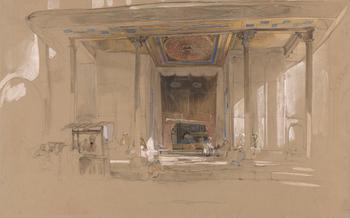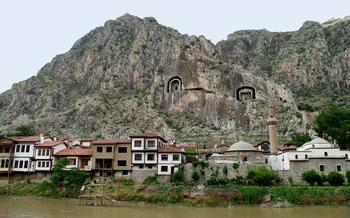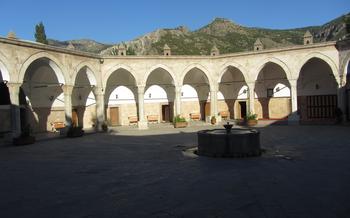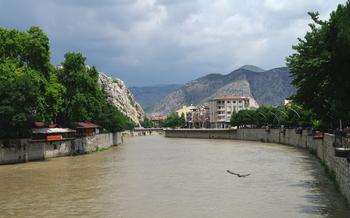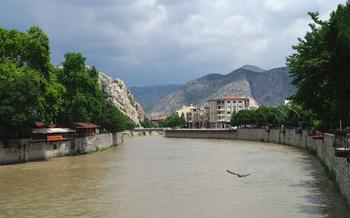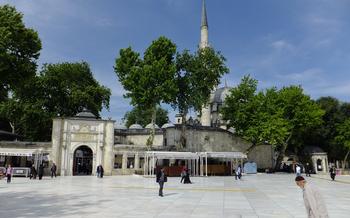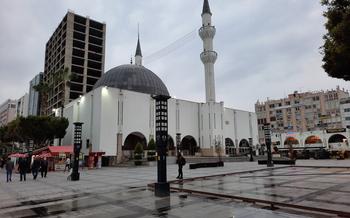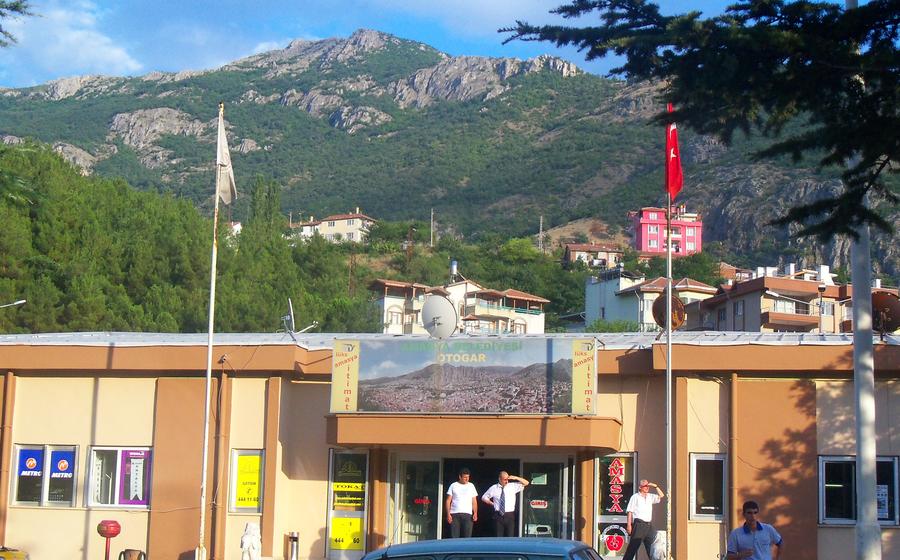
Şeyh Cemaleddin Mosque
- History of the Şeyh Cemaleddin Mosque
- Architecture and Design
- Carvings and Inscriptions
- Dome and Minaret
- Prayer Hall and Mihrab
- Courtyard and Gardens
- Religious Significance
- Cultural Events: A Tapestry of Turkish Heritage
- Visiting Hours and Admission
- Practical Suggestion: Best Time to Visit to Avoid Crowds
- Location and Accessibility
- Practical Suggestion: Recommended routes for a scenic approach
- Nearby Attractions
- Practical Suggestion: A Nearby Hidden Gem Worth Exploring
- History of Amasya
- Local Cuisine and Delicacies
- Accommodation and Where to Stay
- Insider Tip: A Hidden Gem Revealed
History of the Şeyh Cemaleddin Mosque
The Şeyh Cemaleddin Mosque stands as a testament to the rich history and architectural heritage of Amasya. Built in the 15th century during the reign of the Ottoman Sultan Murad II, the mosque holds a significant place in the city's religious and cultural landscape. Its construction is attributed to Şeyh Cemaleddin Efendi, a renowned Sufi mystic and scholar who played a pivotal role in spreading Islam in the region.
The mosque's construction reflects the architectural prowess of the Ottoman era, blending traditional Islamic elements with local influences. It is said that Şeyh Cemaleddin Efendi himself was deeply involved in the mosque's design and construction, ensuring that it embodied his spiritual vision and architectural expertise.
An intriguing anecdote surrounding the mosque's construction tells of a mysterious dream experienced by Şeyh Cemaleddin Efendi. In his dream, he saw a majestic white bird soaring over the city, indicating the spot where the mosque should be built. Guided by this divine revelation, he chose the site where the mosque now stands, amidst the lush greenery and serene ambiance of the city.
Architecture and Design
The Şeyh Cemaleddin Mosque stands out for its unique architectural features. Its exterior is characterized by a combination of Seljuk and Ottoman styles, showcasing the region's rich history. The mosque's entrance is adorned with an intricate portal featuring delicate carvings and inscriptions. The interior of the mosque is equally impressive, with a spacious prayer hall supported by massive pillars. The ceiling is adorned with intricate geometric patterns and colorful tiles, creating a sense of awe and grandeur.
Practical Suggestion: Best Angles for Photography
To capture the mosque's architectural beauty, position yourself in front of the main entrance to capture the symmetrical facade. For a unique perspective, head to the courtyard and shoot from a low angle to emphasize the mosque's towering dome and minaret.
Carvings and Inscriptions
The Şeyh Cemaleddin Mosque boasts an array of intricate carvings and inscriptions that hold deep religious and historical significance. The carvings adorn the walls, arches, and columns, narrating stories and conveying messages through their exquisite craftsmanship.
One of the most prominent carvings is the depiction of a celestial procession, featuring a row of celestial figures riding on fantastical creatures. This carving symbolizes the journey of the soul towards the divine, reminding visitors of the mosque's spiritual purpose. Other carvings portray scenes from the life of Prophet Muhammad (PBUH), offering a visual representation of his teachings and struggles.
The inscriptions, etched in elegant Arabic calligraphy, are equally captivating. Verses from the Quran, hadiths (sayings of the Prophet), and prayers adorn the mosque's interior, creating a sense of reverence and tranquility. The calligraphy is not merely decorative but also carries deep theological and philosophical meanings, inviting visitors to contemplate the wisdom and guidance found within Islamic texts.
To fully appreciate the carvings and inscriptions, it is recommended to obtain a guide or do some research beforehand. This will help you understand the stories and symbols behind these artistic masterpieces, allowing you to delve deeper into the mosque's rich cultural and religious heritage.
Dome and Minaret
The grand dome of the Şeyh Cemaleddin Mosque is a marvel of Islamic architecture. Its intricate design features a series of geometric patterns and motifs, creating a stunning visual spectacle. The dome's interior is adorned with colorful tiles and intricate paintings, adding to its grandeur. The symbolism of the dome is significant in Islamic architecture, representing the heavens and the connection between the earthly and the divine.
The minaret of the mosque is equally impressive, standing tall and slender alongside the dome. Its unique feature is the intricate carvings and inscriptions that adorn its surface. These carvings depict verses from the Quran and other religious texts, adding to the mosque's overall spiritual significance. The minaret serves as a symbol of Islamic faith and a call to prayer for the faithful.
Anecdote:
A legend surrounding the construction of the dome tells of a skilled craftsman who was brought in to oversee the project. As he worked tirelessly, he encountered a series of challenges and setbacks. Undeterred, he persevered and eventually completed the dome. To celebrate his achievement, he placed a small piece of his heart within the structure, ensuring that his spirit would forever be connected to the mosque.
Prayer Hall and Mihrab
The vast prayer hall of the Şeyh Cemaleddin Mosque exudes an atmosphere of serenity and devotion. The spacious interior, adorned with intricate designs and bathed in natural light, invites worshippers to immerse themselves in contemplation and prayer. The mihrab, the focal point of the prayer hall, stands out with its exquisite craftsmanship and intricate tilework. This sacred niche, which indicates the direction of Mecca, holds immense significance in Islamic prayer, as it guides worshippers towards the holiest city in Islam.
The acoustics of the prayer hall are carefully crafted to enhance the spiritual experience. The gentle echoes of recited prayers and Quranic verses reverberate through the space, creating a harmonious and immersive atmosphere. The use of natural light adds to the tranquility of the prayer hall, casting a warm glow on the intricate details of the architecture.
Practical Suggestion: Tips for Respectful Behavior in the Prayer Hall
When visiting the prayer hall, it is essential to observe proper etiquette to ensure a respectful and harmonious environment for worshippers. Visitors should dress modestly and avoid wearing revealing or distracting clothing. It is customary to remove shoes before entering the prayer hall and maintain silence to avoid disturbing worshippers engaged in prayer. Photography is generally not permitted within the prayer hall, and it is important to seek permission before taking any photos. By following these guidelines, visitors can contribute to the peaceful and reverent atmosphere of this sacred space.
Courtyard and Gardens
As you step into the courtyard of the Şeyh Cemaleddin Mosque, you are greeted by a serene and tranquil atmosphere. The courtyard is beautifully landscaped with lush gardens, blooming flowers, and intricately designed water features. The soothing sound of water flowing from the fountains adds to the peaceful ambiance.
The courtyard serves as a gathering place for both religious and social events. During the day, locals and visitors alike come here to relax, socialize, and enjoy the peaceful surroundings. In the evenings, the courtyard transforms into a magical space, illuminated by soft lighting and the gentle glow of the mosque's minarets.
One of the highlights of the courtyard is the stunning marble fountain located in its center. The fountain is adorned with intricate carvings and inscriptions, showcasing the exquisite craftsmanship of the Ottoman era. The water from the fountain cascades into a pool below, creating a soothing and refreshing atmosphere.
The gardens surrounding the courtyard are a testament to the mosque's commitment to environmental sustainability. The gardens are meticulously maintained, showcasing a variety of local plants and flowers. The green spaces provide a welcome respite from the hustle and bustle of the city, offering a peaceful retreat for contemplation and reflection.
Practical Suggestion: Take a moment to sit in the courtyard and soak in the tranquil atmosphere. Enjoy the sound of water flowing from the fountains and the gentle breeze rustling through the leaves of the trees. It is the perfect place to relax and find a moment of peace amidst the bustling city.
Religious Significance
The Şeyh Cemaleddin Mosque holds immense religious significance as a revered place of worship for Muslims in Amasya. It serves as a spiritual sanctuary, fostering a sense of community and belonging among the faithful. The mosque's grandeur and serene atmosphere create an ideal environment for contemplation and devotion.
The mosque's importance extends beyond its role as a place of prayer. It serves as a center for Islamic education and cultural preservation. Classes and workshops on Islamic theology, history, and culture are often held within the mosque's premises, promoting a deeper understanding of the faith.
Moreover, the mosque plays a vital role in organizing religious festivals and celebrations. During special occasions such as Ramadan and Eid, the mosque transforms into a vibrant hub of activity, hosting communal prayers, feasts, and charitable events.
Practical Suggestion: Non-Muslim visitors are welcome to explore the mosque, but it is essential to be respectful of the religious practices and customs observed within. Modest attire is recommended, and visitors should avoid entering the prayer hall during prayer times.
Cultural Events: A Tapestry of Turkish Heritage
The Şeyh Cemaleddin Mosque serves as a vibrant hub for cultural events and activities, showcasing the rich tapestry of Turkish heritage and traditions. Throughout the year, the mosque organizes a diverse array of programs that aim to preserve and promote Islamic culture and history. Visitors can immerse themselves in traditional Turkish music concerts, captivating storytelling sessions, and informative lectures on Islamic art and architecture. These events provide a unique opportunity to delve deeper into the cultural and spiritual essence of Turkey, fostering a sense of community and understanding among locals and visitors alike.
One particularly memorable event I had the privilege of attending was a traditional Sufi music concert held within the mosque's serene courtyard. The enchanting melodies and rhythmic beats filled the air as talented musicians played traditional instruments, creating a mesmerizing atmosphere that transported attendees to another era. The soulful voices of the singers resonated through the courtyard, accompanied by the gentle sway of the audience, who were captivated by the performance. It was a truly magical experience that showcased the power of music to bridge cultures and bring people together.
Visiting Hours and Admission
The Şeyh Cemaleddin Mosque is open to the public daily. Visiting hours are typically from 9:00 am to 6:00 pm, although these may vary during certain times of the year or for special events. Admission to the mosque is free for all visitors.
Before visiting, it is important to be aware of a few guidelines and restrictions. Visitors are expected to dress respectfully, covering their shoulders and knees. Women are also required to wear a headscarf. It is customary to remove shoes before entering the prayer hall.
To make the most of your visit, plan your trip during the early morning or late afternoon to avoid the midday heat. If you are visiting during prayer times, be mindful of the worshippers and try to minimize disruptions. It is also a good idea to check if any special events or ceremonies are taking place before your visit.
Practical Suggestion: Best Time to Visit to Avoid Crowds
To truly appreciate the tranquility and beauty of the Şeyh Cemaleddin Mosque, it is best to avoid visiting during peak tourist season, which falls between July and August. During this time, the mosque can be crowded with visitors, making it difficult to fully immerse yourself in its serene atmosphere.
Instead, aim to visit during the shoulder months of April-May or September-October. The weather is still pleasant during these months, but the crowds are significantly smaller. This will allow you to take your time exploring the mosque, admire its intricate details, and soak in its spiritual ambiance without feeling rushed or overwhelmed.
Location and Accessibility
The Şeyh Cemaleddin Mosque is conveniently located in the heart of Amasya, making it easily accessible for visitors. Situated on Şeyh Cemaleddin Mahallesi, the mosque can be reached by foot, by public transportation, or by taxi. For those arriving by car, there are several parking options available nearby. The mosque is wheelchair accessible, ensuring that visitors with disabilities can explore its wonders without any hindrance.
To fully immerse yourself in the city's charm, consider exploring the area on foot. Take a leisurely stroll along the cobblestone streets, admiring the traditional Ottoman houses and shops. This will lead you to hidden corners and picturesque views that you might otherwise miss. Amasya is a relatively small city, so you can easily cover the main attractions within a day.
Practical Suggestion: Recommended routes for a scenic approach
- Scenic Route 1: Start your walk from the city center and head towards the mosque. Along the way, you'll pass by the Yeşilırmak River and the Amasya Castle. This route offers stunning views of the mosque and the surrounding landscape.
- Scenic Route 2: For a more secluded experience, take a walk along the banks of the Yeşilırmak River. This route will take you past lush greenery and offers serene views of the water. You can also stop at one of the many cafes or restaurants along the river for a refreshing break.
Nearby Attractions
The Şeyh Cemaleddin Mosque is nestled in the heart of Amasya, surrounded by a treasure trove of historical and cultural attractions. To make the most of your visit, consider exploring the nearby sites on foot. A short stroll from the mosque, you'll find the iconic Amasya Castle, perched atop a hill and offering breathtaking panoramic views of the city. Delve into the fascinating history of the castle, which has served as a fortress, a palace, and a prison throughout the centuries.
For a deeper dive into Amasya's rich past, visit the Amasya Museum, which houses a collection of artifacts and exhibits showcasing the city's cultural heritage. Admire ancient pottery, intricate textiles, and historical documents that tell the story of Amasya's role as a crossroads of civilizations.
Nature enthusiasts will delight in exploring the scenic Yeşilırmak River, which meanders through the city. Take a leisurely walk along the riverbank, admiring the lush greenery and the serene atmosphere. For a unique perspective, embark on a boat tour that offers stunning views of the city from the water.
Practical Suggestion: A Nearby Hidden Gem Worth Exploring
Uncover the hidden gem of the Borabay Gölü, a picturesque lake located just a short drive from the mosque. Surrounded by lush forests and tranquil waters, the lake offers a serene escape from the city's hustle and bustle. Enjoy a picnic lunch, take a refreshing swim, or simply relax and soak in the natural beauty of this hidden paradise.
History of Amasya
Amasya, a city nestled in the heart of Turkey, boasts a rich and diverse history that dates back to ancient times. Once home to various civilizations, including the Hittites, Persians, and Romans, Amasya served as the capital of the Pontus Kingdom during the Hellenistic period. Throughout the centuries, the city witnessed the rise and fall of numerous empires, leaving behind a tapestry of cultural influences that can still be seen today.
With its strategic location along the banks of the Yeşilırmak River, Amasya became a vital trading hub, attracting merchants and travelers from far and wide. The city's prosperity and cultural exchange played a significant role in shaping its unique identity. Amasya was also a center of learning and scholarship, with renowned scholars and artists contributing to its intellectual and cultural development.
In the 15th century, Amasya came under the rule of the Ottoman Empire, ushering in a new era of growth and transformation. The city became a vital administrative center and a hub for religious and cultural activities. The construction of the Şeyh Cemaleddin Mosque during this period stands as a testament to the city's architectural prowess and its enduring Islamic heritage.
Today, Amasya remains a vibrant and culturally rich city, where the past and present intertwine. Visitors can explore its historical sites, admire its architectural wonders, and immerse themselves in its unique blend of cultures. Amasya's rich history continues to inspire and captivate those who visit this enchanting city.
Local Cuisine and Delicacies
Amasya offers a diverse culinary scene that showcases the region's rich history and cultural influences. Savor the famous Çevirme, a slow-cooked lamb dish that melts in your mouth. Indulge in Amasya Elması, a unique variety of apple known for its sweetness and aroma. Don't miss the chance to try Tokat Kebabı, a delectable meat dish served with grilled tomatoes and peppers.
For a taste of traditional Turkish cuisine, head to the local restaurants and eateries in the city center. Kebapçı Halil Usta is a must-visit for its mouthwatering kebabs, while Hacıoğlu Konağı offers a refined dining experience in a historic setting.
When it comes to sweets, Amasya is renowned for its Amasya Tatlısı, a delicate pastry filled with walnuts and drizzled with syrup. For a sweet treat on the go, try Simit, a circular bread topped with sesame seeds.
As you explore the city, don't forget to try Çay, the ubiquitous Turkish tea, served in small tulip-shaped glasses. For a refreshing drink, opt for Şalgam Suyu, a fermented turnip juice with a unique tangy flavor.
Anecdote:
During my stay in Amasya, I had the pleasure of dining at a local restaurant that served traditional Turkish cuisine. The aromas wafting from the kitchen were simply irresistible. I started with a plate of Meze, a selection of small dishes that included hummus, baba ghanoush, and yaprak sarma (stuffed vine leaves). For my main course, I opted for the Testi Kebabı, a clay pot kebab that was cooked to perfection. The meat was tender and juicy, and the flavors were simply divine. The meal was accompanied by a refreshing glass of Ayran, a yogurt-based drink. It was an unforgettable culinary experience that left me craving for more.
Accommodation and Where to Stay
When planning your trip to Amasya, finding the perfect place to stay is essential. Fortunately, the city offers a range of accommodation options to suit every budget and preference.
Recommendations for Budget-Friendly Stays:
-
Amasya Hostel: Located in the heart of the city, this hostel offers affordable dorm rooms and private rooms with shared bathrooms. It's a great option for budget travelers looking for a social atmosphere.
-
Şeyh Cemaleddin Hotel: This small, family-run hotel is just a short walk from the mosque. It offers basic but comfortable rooms at an affordable price.
Recommendations for Luxury Stays:
-
Divan Amasya: This five-star hotel is situated on the banks of the Yeşilırmak River and offers stunning views of the city. It features luxurious rooms and suites, a spa, and several fine dining restaurants.
-
Grand Hotel Amasya: This historic hotel is located in a restored Ottoman-era building. It offers elegant rooms and suites, a rooftop terrace with panoramic city views, and a traditional Turkish bath.
Tips for Finding the Best Deals and Discounts:
-
Book in Advance: To get the best rates, book your accommodation well in advance, especially if you're visiting during peak season.
-
Look for Discounts: Many hotels and guesthouses offer discounts for online bookings or extended stays.
-
Consider Local Guesthouses: For a more authentic experience, consider staying in a local guesthouse. These guesthouses often offer lower prices and a chance to interact with local families.
Practical Suggestion: Local Guesthouses for an Authentic Experience
For a truly immersive experience, stay at one of Amasya's many local guesthouses. These guesthouses are typically family-run and offer a warm and welcoming atmosphere. You'll have the opportunity to learn about Turkish culture and traditions while enjoying delicious home-cooked meals.
Insider Tip: A Hidden Gem Revealed
For those seeking a unique perspective of the Şeyh Cemaleddin Mosque, venture to the rooftop terrace of the nearby historical Hamam Museum. This hidden gem offers a panoramic view of the mosque's stunning dome and minaret, set against the backdrop of the picturesque city skyline. As the sun casts its golden hues, the mosque's intricate details and grandeur come alive, creating a breathtaking sight. Capture this enchanting moment with your camera and cherish the memory of this hidden treasure.

